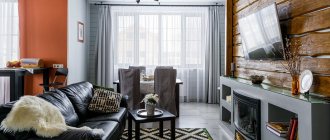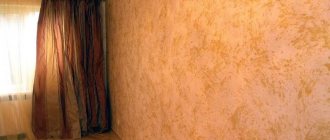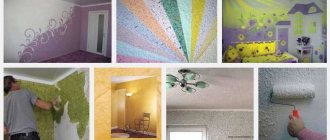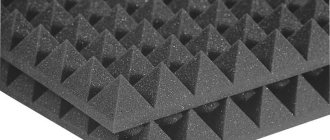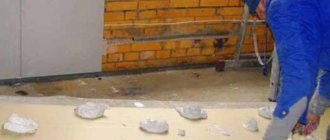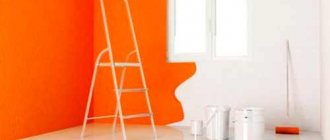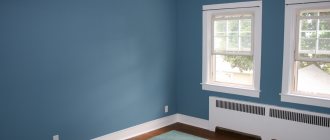Kinds
For the manufacture of noise-insulating coatings, raw materials are used, which give the product its special properties. This decoration will decorate the room and protect the room from external noise.
There are two types of noise: airborne and impact. The first type occurs from a loud voice or switched on equipment (TV), the second is transmitted through the building structures - these are the sounds of impacts, falling or dragging of large objects. A material that has a soundproofing effect absorbs noise. There are several types of wallpaper with this effect.
Cork
There are several types of cork wallpaper, but more often it is a multi-layer material. Advantages of cork covering:
- Does not cause allergies, so can be used in bedrooms and children's rooms.
- Thermal and sound insulating properties provide a comfortable environment.
- The natural composition has a beneficial effect on the microclimate in the room.
- Dust particles and dirt are not attracted to the surface.
- The cork “breathes”, so it is not afraid of fungus.
- Does not lose properties when exposed to ultraviolet radiation.
- The unique texture creates a cozy atmosphere.
Cons: cost, fragility. You need to stick it carefully so as not to damage the edges.
Color is limited to natural shades - from light to dark, variety comes from different particle sizes
Types of cork products for wall decoration that have soundproofing abilities:
- Coatings without base. Available in roll form. Very fragile.
- With paper base. Durable due to the backing. Securely attached to the wall.
- Non-woven based products. Wear-resistant, very durable.
- Coatings with an adhesive base. Easy to stick.
- Plates. Very durable, thick, but more expensive.
The advantage is the natural composition. Cork products contain natural ingredients - cork tree bark, resin as a binding raw material. The components are heated and then pressed, resulting in a monolithic coating.
What to consider when choosing a material?
All modern materials have different properties and are used in certain conditions. In order to choose the right material, you need to know and understand the features of the room where you plan to finish it with soundproofing material.
Noises are divided into:
- Airborne noise. Occurs by spreading through the air, for example, people screaming, music playing or a car alarm going off.
- Impact noise. Sounds passing through walls and ceilings originate from mechanical influence. It is also called structural noise, associated with the movement of furniture, drilling or movement of liquid through sewer pipes, falling of heavy objects, and the clicking of heels.
Materials can be:
- Sound-absorbing. Designed to absorb all noise inside the structure. They have a granular or fibrous structure. Light weight and low cost greatly facilitate the installation of this group of materials.
- Soundproof. On the contrary, they do not allow sounds, reflecting them at the entrance. The best way to solve the problem of noise penetration from the street. They have a large mass and dimensions, and are quite difficult to install on your own.
When choosing a soundproofing material, it is important to pay attention to the environmental component, especially if it will be used in children's rooms or among the elderly.
Advice! When calculating the cost of sound insulation, take into account not only the material, but also the components for its fastening or installation (lathing, fasteners, glue, etc.). As a result, the cheapest one may turn out to be more expensive.
Vinyl covering
Vinyl sheets with a non-woven base show good soundproofing qualities. The canvas is durable, rigid, as well as the non-woven backing, prevent noise from penetrating into the room.
This material has a noticeable relief pattern on the surface.
Features of vinyl coverings:
- The thick canvas hides small irregularities on the wall surface.
- After gluing it does not shrink.
- Easy to care for.
- Holds well on horizontal and vertical surfaces.
- Wide range of textures, shades.
The wear resistance of the coating, compared to cork, is higher, and therefore the service life of the finish is longer. But in terms of noise absorption, cork is better.
Velours
The peculiarity of artificial velor is its high strength; there is no need to worry about the front layer. Noise reduction level is average. The canvases have a paper or foam base. The front layer does not fade and does not lose its attractiveness throughout the entire service life of the finish. It is better to use the coating in the living room, office, bedroom.
Velor fabrics have a fleecy pattern on the surface - hence the name of the material
Carpet (tufting) wallpaper
Carpet, tufted wallpaper is a two-layer material for wall decoration with high heat and sound insulation properties. The backing is fabric, the top is pile. Applied by machine. The product is artificial, but safe.
Externally similar to carpet
Despite their high “breathing” ability, they have high thermal insulation properties. The surface is easy to care for - it dries quickly when wet, and dust can be removed with a regular vacuum cleaner. The canvases are heavy - this must be taken into account when choosing an adhesive composition.
Pros and cons of various sound-absorbing wallpapers
Now that the main types of sound-absorbing wallpaper are presented, it will be useful to clearly outline the advantages and disadvantages of each type.
Tufting wallpaper
Pros:
- Good sound insulation
- Additional thermal insulation
- Beautiful appearance, which is ensured by a large designer variety of colors and types of finishes of such wallpapers
- Ease of care
- Safety for humans - non-toxic, biologically inert, does not contain hazardous compounds
- Moisture resistant, tolerates contact with water well, dries quickly
- Simple and easy to install
- Do not fade, are not affected by UV rays
- Well hides minor imperfections of the base surface
- Have high tensile strength
Minuses:
- Accumulate electrostatic charge and attract dust
- Dust accumulates between the villi and can trigger an asthma attack in chronic patients with this disease.
- Requires frequent maintenance to remove accumulated dust
- Poorly tolerate mechanical stress
- Have a relatively high cost
Tufted wallpaper is a good solution for residential premises and public enterprises. They not only insulate rooms from excessive noise, but also insulate well, so it makes sense to use them on cold external walls, soundproof and at the same time insulate joints.
Faux velor wallpaper
pros
- Attractive appearance
- Average degree of sound insulation
- Wallpaper does not fade in the sun and near the central heating radiator
- Average price category, velor wallpapers are cheaper than tufting or cork
- Quick and easy to apply
- Can be cleaned using a soft brush of a vacuum cleaner
Minuses
- Just like tufting, they accumulate electrostatics due to their artificial origin. The consequence is rapid contamination of the coating.
- Relatively low durability. The service life rarely exceeds 5 years.
- Does not tolerate moisture and water
- Practically, they do not resist mechanical stress, the decorative layer is very vulnerable
Artificial velor wallpaper is most suitable for the apartment of a single person, without pets, or for decorating a quiet office with few employees. Then this type of coating will be able to reduce the level of external noise, and not be subjected to serious operational loads for which it is simply not intended.
Cork wallpaper
pros
- Natural, natural material, environmentally friendly and safe
- Provide a high level of sound insulation
- Provide natural ventilation of the room
- Absolutely safe for humans, can be used in children's and medical institutions, and is also suitable for people with health problems.
- Moisture resistant
- They are durable and resistant to operating loads
- Have good adhesion to almost any surface
- They are highly combinatorial and can be integrated into almost any interior style
- They are easy to care for with a simple soft brush, since cork wallpaper does not accumulate static and does not attract dust. If contamination occurs, it can be removed with a damp cloth and a non-aggressive care product.
Minuses
- High price
- Cork wallpaper requires a flat surface, since due to its thin structure, unevenness on the wall will be clearly visible. Cork slabs are not so capricious; their thickness allows you to effectively hide minor imperfections in the finishing of the base wall.
- Cork wallpaper must be glued as carefully as possible, since negligence or carelessness will be clearly visible on a flat wall. Therefore, if you are not confident in your abilities, it is better to invite specially trained craftsmen.
Cork wallpaper is a universal means of soundproofing rooms for any purpose. They are suitable for both the external wall of a panel house and interior walls. They will save you from the sounds of the city street or from too noisy neighbors. If the noise level is very high, cork wallpaper can be replaced with cork tiles or roll covering. Then the sound insulation result will be even more impressive.
Sound-absorbing wallpaper: advantages, disadvantages
All products have their pros and cons, but they all have the following features in common:
- Safety for humans and the environment. Not all types are made only from natural ingredients, but all are safe and do not emit odor or harmful substances. Only cork is 100% environmentally friendly, as it consists of natural raw materials. Hence the cost.
- Taffeta and vinyl coverings can be used in rooms with high humidity. It is better to protect cork and velor from moisture.
- With the exception of cork, other types have different colors and textured patterns. Cork looks natural, but does not fit into all interiors. Looks good in cabinets, offices, and residential interiors in eco style.
- The most durable are vinyl wallpapers (last up to 10 years), others require more careful treatment and periodic updating.
- There are no difficulties when gluing soundproofing sheets. Just be careful when working with cork so as not to damage the edges.
- The most expensive are cork, velor, carpet; cheap - vinyl.
Advantages of soundproofing wall finishing
The process of installing sound insulation in your own apartment will not take much time and effort. First, there are some important things you should know, including the difference between sound insulation and sound absorption. In the first case, noise does not penetrate from adjacent apartments, while in the second, sounds from your room will no longer reach the ears of your neighbors.
Soundproofing under wallpaper can please residents with the following positive qualities and advantages:
- Increased level of comfort - conversations of neighbors, loud music and all other extraneous noise will be eliminated.
- Some finishing materials have a remarkable appearance and decorative properties, which allows them to be used as a finishing coating without the need to glue vinyl wallpaper.
- It becomes possible to make noise yourself, within reason, without causing inconvenience to people in adjacent rooms.
- Modern materials provide not only noise protection, but also excellent thermal insulation characteristics.
The only serious drawback is that the usable living area is reduced. This point is especially important for owners of small apartments, where every centimeter plays a big role. In this case, it is recommended to choose frameless finishing options, as well as use thin membranes and sound-absorbing wallpaper.
Sequence of actions when gluing
The method of fixing the canvas depends on the qualities. But first, you need to prepare the walls:
- Remove old finish.
- Completely clean the walls from dirt and dust, wash them and dry them.
- Repair damaged areas, fill cracks, remove foreign bodies protruding from the wall.
- Treat the walls with a primer - it will additionally remove dust from the surface, reduce absorbency, and increase adhesion.
Preparation
How to glue different types of wallpaper:
- Before you start gluing the cork, you should study the instructions on the package. The manufacturer provides instructions regarding the sequence of work. For example, glue can be applied only to the canvas, only to the walls, or to both surfaces. Some types of cork have a self-adhesive backing. Glue the sheets end to end.
- When gluing vinyl sheets on a non-woven backing, glue is applied to the walls. The canvases are also glued end-to-end.
- When gluing velor trellises, you need to take into account the features of the front layer. It must not be dirty or damaged. First, a non-woven base is glued to the wall, and then velor sheets. The adhesive should be intended for “heavy” wallpaper.
- Carpet wallpaper is also heavy, so the same glue is used for it as for vinyl sheets. Apply the composition to the wall. The canvas is glued from top to bottom, smoothing from the center to the edges.
Strip layout scheme
Installation
Installation technologies for modern soundproofing materials vary depending on the material chosen.
Using dowel nails
Such a system is used in such materials as Phonestar GW. The panels are fastened using special dowel-nails, which are inserted into the designated holes in the panels. You need to drill holes in the wall in advance to connect it and the panels.
Installation should begin from left to right and from bottom to top. Before installing the outer panel, its outer edges are cut off. The starting bar is installed close to the wall.
Applying plaster
Installing acoustic plaster yourself can cause many problems, as it requires certain skills. Beacons are pre-installed, which allow you to create a flat surface.
The plaster application process consists of three stages. The first step involves spraying a thick mixture as a base. The second stage involves filling the voids. The third is needed to consolidate the result.
Adhesive base
Such materials produced by SOFTBOARD are applied to a specially prepared adhesive base. Liquid nails intended for this purpose can be used as glue. Liquid nails are applied along the edges and in a couple of places in the center. First, the surface of the base is leveled using plaster.
The process of installing soundproofing material under wallpaper should not cause much difficulty, especially if you have certain skills. In order to get an excellent result at the end of the repair, you must fully comply with the installation technology:
- Preparing the wall surface. First you need to prepare the work surface where the material will be glued. To do this, it is necessary to eliminate defects in the form of large cracks. This is done using plaster, which is applied with a spatula; the surface is first primed. There should be no previous material left on the wall.
- Cutting strips. Soundproofing underlay for walls is sold in rolls over 10 meters long. Before gluing, it must be divided into strips equal to the height of the room. If possible, this should be done with a small margin, especially in the absence of practical skills, so that there is room for maneuver.
- Applying glue. Depending on the material used, the adhesive is applied to various surfaces; when using a non-woven backing, the adhesive is applied exclusively to the walls; polyurethane material requires additional application to the backing itself.
- Gluing strips. After applying the glue, you can proceed to gluing the strips. This must be done carefully to ensure neat joints. They should not stick out or puff up. Additionally, you can apply paper tape to the joints to obtain a better result.
- Drying. After completing the work, you need to let the glue dry. It is prohibited to perform any manipulations with the substrate within 72 hours. Only after the expiration of the period can the finishing work begin.
Modern soundproofing materials make a person’s life much more comfortable, eliminating extraneous noise, which can cause significant harm to his health. However, installation of the material also has its drawbacks, but they are compensated by a large number of positive aspects. It is up to everyone to decide whether to use it or not.
In the video you will see the process of sound and noise insulation of walls, and will also tell you what materials are needed and their cost.
Life in modern cities is becoming more and more stressful. The noise does not subside either day or night. The rhythm of people’s lives also changes, and at the hour when many are preparing to rest, some are just entering the active stage of wakefulness. All this creates additional noise pollution, which must be reduced in order to ensure comfort and peace for yourself and your loved ones. Modern sound-absorbing wallpaper can help with this.
Wallpaper bases with soundproofing effect
If you want to achieve a comfortable level of sound insulation of the room, but the listed coatings are not satisfactory, you can use another finish together with soundproofing bases.
Preparing the wall with backing
When soundproofing walls, you can use backings as a base for any type of wallpaper. Additionally, the material levels the walls. Advantages:
- Safe composition.
- Thermal insulation effect.
- Durability.
There are many types of underlays in hardware stores.
SoundGuard: soundproofing membrane
The peculiarity of the synthetic coating is its small thickness (no more than 2 mm). Therefore, the membrane can be used in combination with any finish. Soundproofing qualities are ensured by the large weight of the substrate.
MAXFORTE
The products of this manufacturer are popular. Provides comfort depending on the noise level in the room.
Technoelast-acoustic, Technolight from TechnoNikol
Technoelast-Acoustic protects against impact noise. Technolight is made of stone wool and is used to improve the quality of floors and ceilings.
Soundproofing canvas "ZvukoIzol"
A polymer material with universal characteristics that has sound, heat and waterproofing properties. More durable than similar products.
Tecsound
The material has a slight thickness (0.37 cm), so it can be used under any coating - thin, dense relief. The thin base holds up to 28 dB, with other coatings the protective effect is enhanced
Isoplast
Universal material for any premises. Externally, the substrate is similar to roofing felt and is highly durable. Availability, convenient format - in the form of rolls, operational characteristics allow use for internal and external (roof waterproofing) work.
Sandwich panels (ZIPS)
Boards with a fibrous structure allow you to obtain high-quality noise protection for your premises. Thanks to the grooves, a tight fit of the elements is ensured. The small thickness makes it possible to use the panels even in small rooms.
SoftBoard
The name literally translates as “soft board”. Natural raw materials are used to produce boards with a fibrous porous structure. It is recommended to use in spacious rooms; due to the large thickness, centimeters of the area of a small room will be lost.
German material PhoneStar
The small thickness (1.2 cm), high density of the three-layer material allows you to save the area of a small room and reliably protect it from noise. Made from natural raw materials (cardboard, rubber, quartz sand). The structure of the panel ensures reflection and dispersion of sound waves.
Plaster
Soundproofing plaster contains granular filler that reflects sounds. Despite the thin layer of application, the coating provides sound insulation. The advantage is accessibility.
Prices for soundproofing materials and acoustic wallpaper
- The noise-absorbing material, which is created from foam rubber panels, helps to create an excellent acoustic effect in the apartment, its price is 1,535 rubles / package.
- European volumetric wallpaper stickers with a 3D effect - the cost varies from 230 to 29.5 thousand per piece.
- Self-adhesive wallpaper, which is made of foam - the price is 361 rubles / piece.
- Acoustic panel that allows you to create excellent sound insulation - from 111 rubles / piece.
- Acoustic panels made of leather with 3D effect - 21.1 thousand rubles/lot.
- Polyester acoustic wallpaper - from 1.4 thousand to 1,772 rubles / lot.
- Foam acoustic panel - from RUB 1,650.
- Decorative acoustic panels made of leather - from 22.1 thousand/lot.
- Self-adhesive 3D wallpaper “brick-like” - from 525 to 880 rubles/piece.
- PVC for gluing walls - from 153, 562 rubles / lot.
Soundproofing materials that are used to create comfort in an apartment differ in cost and the material from which they are made.
Before purchasing, you need to check with specialists for which room such wallpaper is suitable and whether it can be used as a backing.
Which material is the thinnest?
The most applicable material is polyethylene foam.
It is used as a backing for wallpaper. Installation is easy. Material properties:
- does not rot;
- has low weight;
- high porosity;
- low thermal conductivity.
The second option is a cork backing. It has good soundproofing properties, is not safe for health, and has thermal insulation qualities. Basically, the substrate is used in private homes not only as a sound insulator, but also as insulation. Installation is carried out using glue.
The third option is non-woven fabric. It has good vapor permeability. When installed on walls, the material hides minor surface defects. The length of 1 roll is 10-12 meters. Width – 60-100 cm. Non-woven fabric is glued vertically and horizontally.
Tufting and velor – what will surprise you with these materials?
The substrate is not the only representative of soundproof wallpaper. Thus, tufted wallpaper, which is a product with several layers of dense fabric and pile, will be an excellent protection for the walls in the apartment. Resembling a carpet, tufting stands out among other examples of this niche product due to its high strength and porosity. As a result, such wallpaper will cope with noise from neighbors, while at the same time keeping the house warm.
Positive qualities include ease of washing, moisture resistance, resistance to fading and ultraviolet rays. Tufted wallpaper can be used independently, without covering it with a new layer of vinyl or paper wallpaper. This is facilitated by a huge range of products, differing in structure, density and color palette.
The coating based on artificial velor looks very stylish and beautiful. Outwardly, such wallpapers look like velvet, but their density is an order of magnitude higher. Vinyl-glued paper serves as the base. Velor coverings can please buyers with such positive properties as:
- Simple and quick cleaning with a regular vacuum cleaner.
- Easy to install.
- Low cost.
- Remarkable decorative properties.
But the shortcomings could not be avoided. Thus, dust accumulates abundantly on the surface, so caring for them, although simple, will have to be done quite often. Velor does not tolerate mechanical damage well, so it is not recommended to glue them in apartments with children or animals.
What effect can you expect from soundproof wallpaper?
One of the most popular ways to solve the problem of loud neighbors is to apply wallpaper underlay. This is a special roll material, produced from foamed polyethylene, covered on both sides with durable paper.
The substrate, which is called sound-absorbing wallpaper, belongs to the category of universal products. Thus, the use of such coatings makes it possible to level the surface of the base, ensure the maximum level of silence in the room, and also insulate the walls.
The cost is quite high, but the price is completely justified, since the product will delight apartment owners with many other important qualities:
- Environmentally friendly - clean and safe products are used for production. The result was the absence of any dangerous fumes that threaten the life and health of children and adults.
- Resistance to microorganisms - modern materials prevent the spread of mold and fungal parasites, and they are not susceptible to rotting.
- The presence of a special thermal insulation layer prevents the escape of thermal energy from the room, preventing drops of condensation from accumulating on the wallpaper.
Installing such a membrane under the wallpaper will not reduce the usable area of the apartment in any way, since the fabric is very thin. Its thickness does not exceed a few millimeters. The operating period is quite long, so manufacturers boldly set a warranty period of up to 50 years.
Various non-woven materials are most often used as a backing for paper or vinyl coverings: non-woven fabric, polyethylene sheet, cork. The choice of base is influenced by factors such as the features of the walls, the preferences of buyers, and their financial capabilities. The key difference between these materials is their density and thickness.
Thus, purchasing cork products, which are the most durable, makes it possible to do without lengthy and careful leveling of the concrete base. Pasting walls with polyethylene foam allows you to reduce the costs associated with puttying. Among the positive properties of non-woven fabrics, one can note the protection of applied wallpaper from tears and the prevention of cracking of the base.
Decorative panels are a new word in soundproofing walls
Ready-made decorative panels greatly facilitate the task of soundproofing walls in an apartment. But their use becomes possible if the rooms have perfectly smooth walls. And all because many similar products are fastened to each other using the tongue-and-groove system. If there is a noticeable difference in height, the panels will simply move. There are quite a lot of advantages of decorative soundproofing panels.
- Each weighs about four kilograms, so one person can work with individual elements.
- Once installed in the room, the decorative panel will not need to be further decorated. And this is a significant saving.
- Soundproofing panels are attached directly to the wall using special fasteners or glue; the frameless system does not take centimeters away from the room.
- Simplicity of installation, excellent final result, high sound insulation properties - the described sound insulation of walls in an apartment is chosen when it is necessary to protect everything: both internal and external partitions.
If the walls in an apartment are soundproofed using wall panels, it is important to meet certain conditions: the installation itself takes place only in dry rooms, when all the “wet” work has already been completed
Installation can be done in two ways: on the lathing and with glue. The lathing option is chosen when it is not possible to level the walls or you want to save as much as possible on such work. For example, if you plan to soundproof uneven brick walls in a new house, it is better to choose installation on the sheathing for installing decorative panels.
For its manufacture, bars with a cross section of 19x44 mm are used. They are attached to the walls using self-tapping screws in increments of 29 cm. After completing the installation of the frame, decorative soundproofing panels are applied to the planks and attached to them using special brackets (their length is 10-14 mm).
Decorative sound insulation for walls whose surface has a perfectly smooth structure can simply be glued to the existing base. Special glue is not applied to the entire slab; it needs to be spread in strips around the perimeter at a distance of 2 cm from the edges of the decorative element, then the center is marked with drops every 20 cm. After this, the soundproofing panel is simply applied to the wall and pressed against it. The next element is pressed against the wall slightly to the side of the first panel, and then moved laterally to the already glued element.
Do-it-yourself soundproofing of walls
Before soundproofing, you should always inspect the walls for cracks and holes, which are best filled with putty. This is the main component of comprehensive sound insulation. After sealing the cracks, less noise will enter the room.
The second stage in the fight against annoying noise is to inspect the mounting sockets of sockets and switches. To do this, you need to turn off the power to the room where the soundproofing work is being done. This is being barked at in the common sign at the entrance. After turning off the power, you still need to check the socket or switch for functionality. If there are no signs of current, then you can safely get to work. To begin with, the contents of the socket are pulled out, the empty space behind it is filled with foam rubber, glass wool or polystyrene foam; other materials will also be suitable. Then this structure is sealed with a quick-setting building mixture and after it dries a little, a socket or switch is installed. This treatment of the landing nests will significantly reduce the amount of incoming noise.
You can also take a different route and simply move the socket to a new location and fill the old hole with foam.
The third stage of preparation for soundproofing is sealing the holes and cracks that appear at the junction of heating and water pipes to the wall. It is imperative to fill all significant holes with soundproofing material and cover with a layer of cement mortar or putty. Only these actions in combination can reduce noise in the room to a good level, resulting in the creation of correct and effective sound insulation of the walls.
To perform noise and sound insulation of the walls, it is necessary to make a frame.
If the room has loose windows and doors, then no soundproofing of the walls will help. First you need to replace them.
To obtain high-quality protection, you do not need to mount the profile on the wall. It is better to step back 2 cm from it and make a gasket made of rubber or cork. Vibration isolation will reduce the possibility of sound penetration.
After constructing the frame, the most important stage begins - working with sound-absorbing materials. And if you don’t make mistakes at this stage, then you will be provided with sound insulation of the apartment at the highest level.
Laying mineral wool and installing panels does not cause any difficulties. In the case of soft materials, careful padding is necessary. The denser the wool is laid, the better the sound insulation.
It is very important to fill all the cracks, especially those near the profiles. It is also recommended to compact their cavities tightly with cotton wool.
This will reduce the sonority. If there are any gaps left after installation, they can be filled with foam.
The gluing process - step-by-step instructions
Soundproofing wallpaper is sometimes glued after the membrane, but if the room is close to the exit from the apartment, then it is better to use cork elements, then the sound from the entrance will not disturb the peace of the residents. Algorithm of actions:
- The previous layer of facing elements is removed, but careful leveling of the surface is not required. Plaster, old finishing, everything that can be easily removed is removed.
- After this, the wall should dry well. Craftsmen sometimes use construction heaters to speed up this process.
- If you have chosen wallpaper that already has a backing, the gluing procedure will take place in one stage. There is no need to first cover the surface with soundproofing building materials.
- The wall is treated with an adhesive composition. If non-woven wallpaper is selected, then the appropriate glue is purchased.
- The roll is rolled out on the floor, sheets of the required length are cut. The gluing is carried out joint to joint.
We recommend: Soundproofing the floor in an apartment under a screed
If you purchased ordinary wallpaper, then the first step is to lay soundproofing material. It should dry for about a day. Only after this can the facing elements be glued.
